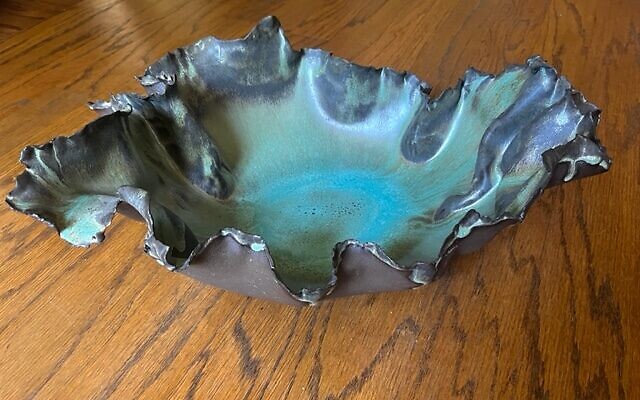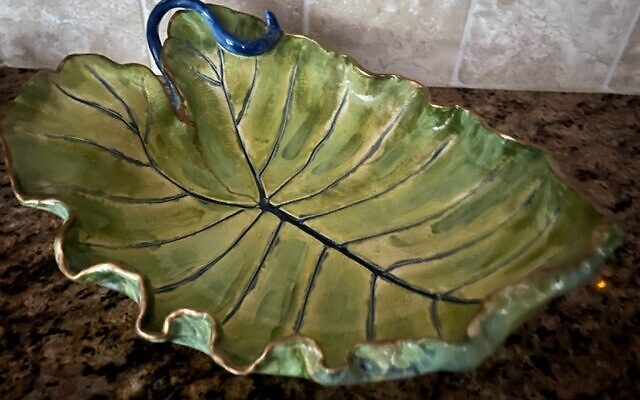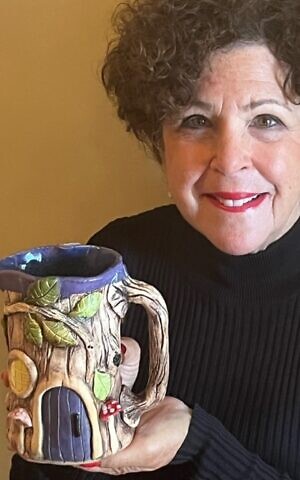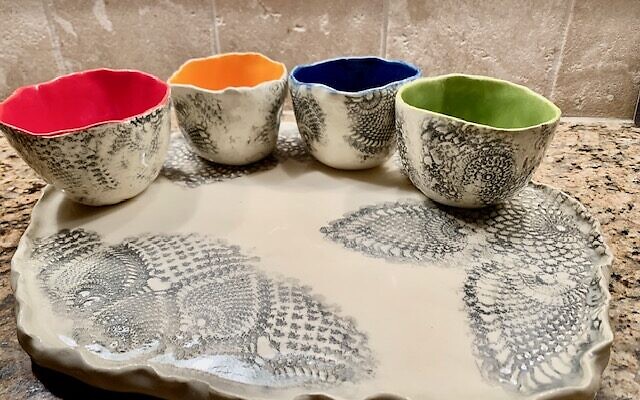Helen Lets the Clay do the Talking
Helen Oxman Kraus processes the world around her to arrive at whimsical clay art forms.
After 37 years with the Atlanta Journal-Constitution and now with the AJT, , Jaffe’s focus is lifestyle, art, dining, fashion, and community events with emphasis on Jewish movers and shakers.
Helen Oxman Kraus has attracted a fan base of those who appreciate creativity, whimsy, and often useful pottery in various shapes and hues.
Trained as a therapist, Kraus shared, “My work with clay is ‘hand building,’ which means taking a 20-pound brick of clay, cutting off slabs and creating something from it. This is a very different method than wheel work, which is what most people think of as pottery. It’s a childlike feeling when I’m playing with clay. The ability to add, take away, manipulate, texturize, alter the clay, and get an immediate outcome is magical. It really engages my inner child – both the process of using my imagination while working the clay plus the whimsical finishing of many of my pieces.”
Kraus grew up in Atlanta, graduated from University of Georgia with a degree in advertising/public relations and a graphic design minor. She earned her master’s at the University of Maryland. Over the years, she has enjoyed various artsy ventures…photography, stained glass, multimedia collage, and computer-made short movies. Twenty years ago, she decided to work with clay at Abernathy Arts Center, then moved to Spruill Arts Center.

Kraus celebrates her color choices to arrive at “HELEN’S WHIMSICAL WORKS,” many of which are hand painted, while using traditional glazing methods for others. She approaches her work in two different ways.
“Sometimes, I start with an idea of an object, usually a functional or utilitarian piece, beginning with a rough pattern for size. I have made functional pieces like pitchers, bowls, vases, platters, plates, mugs, tea pots, wall signs, children’s items, and house gifts. Unlike most ‘wheel’ pieces, they usually incorporate asymmetry, embellishment, or texture as the essential design. At other times, I let the clay do the talking and take its own form.”

Kraus enjoys the process of letting go of structured expectations for pieces which she labels “organic” or “freeform,” not necessarily functional. She observed, “There’s a lot of self-growth and discovery that comes from working with clay. I have learned that there are real limits to our control. The stages of creating include building, drying, and firing. Each stage has its risk of failing. The outcome of a piece may not be what I visualized, planned, or wanted, and yet, it can be better…or it can be disappointing. Some of my biggest disappointments have been pieces that have cracked or not fired correctly.”
She works with the “mishap” and often ends with pieces that are among her favorites. This is in line with the Japanese philosophy, “Wabi Sabi,” or seeing the beauty in the imperfection of “what is” as a piece may not be what was planned, but it can acquire a different beauty of its own.

The completion of a piece can take anywhere from two weeks to four months, depending on the complexity, including its size, number of layers of embellishment, texturizing, and colors applied for the glaze. As she works with a piece, Kraus can get further inspired to add more details, “which is joyful but time consuming.” There is also a slow mandatory drying time where pieces must dry evenly to keep from cracking.
Kraus draws inspiration from other artists, textures and shapes that often go unnoticed. Building with clay has helped her appreciate texture, color, and form in the natural and material world. Objects she has used for texturing can be offbeat: a rubber floor mat, window screening, surface of a metal shelf, forks, screws, washers, herbs, flowers, leaves, tree bark, kitchen tools and fabrics. Her favorite texturing objects are her grandmother’s crochet doilies, connecting her art with her family’s past.
She said, “Often viewers don’t recognize what or where the textures are from in my pieces. I use a lot of color, with my favorite palette being saturated brights. I find it energizing to use colors that bring out a whimsical, playful side of me. Glazing is the last thing to do to finish a piece, and when the glaze is satisfactory, then I feel happy.”
Kraus sells pieces by commission, through Facebook and her favorite: word of mouth. For more information, contact therapywithhelen@gmail.com.
- Arts and Culture
- Local
- Marcia Caller Jaffe
- Helen Oxman Kraus
- pottery
- University of Georgia
- advertising/public relations
- Graphic Design
- University of Maryland
- photography
- stained glass
- multimedia collage
- Abernathy Arts Center
- Spruill Arts Center
- HELEN’S WHIMSICAL WORKS
- pitchers
- bowls
- vases
- platters
- plates
- mugs
- tea pots
- wall signs
- Wabi Sabi




comments